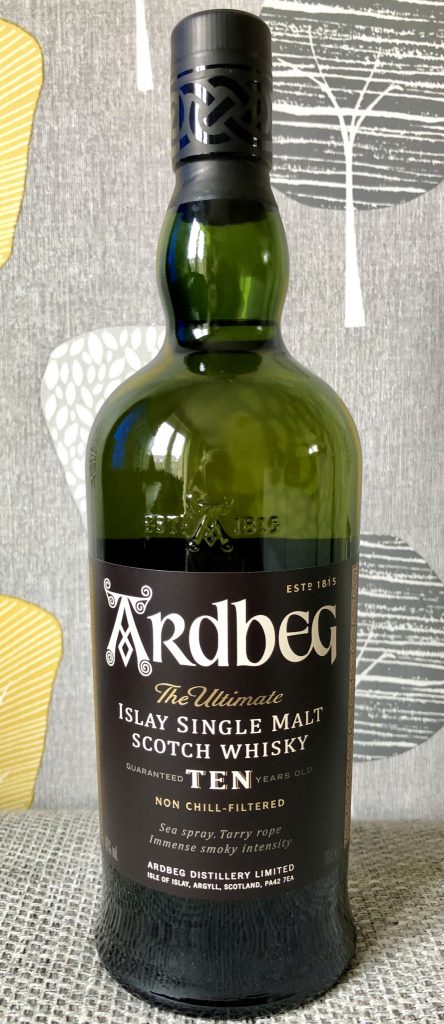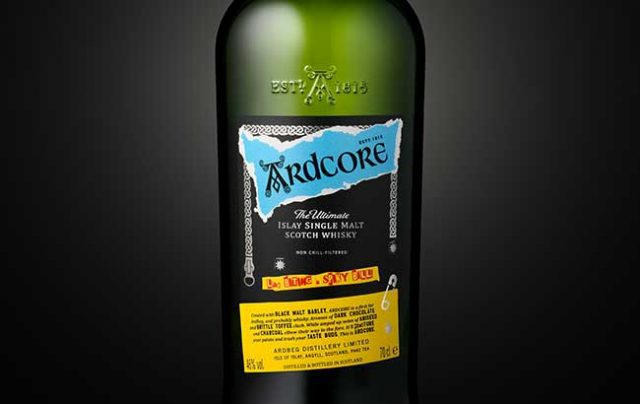Ardbeg 10

Ardbeg recently announced the upcoming release of their Fèis Ìle 2022 bottling, Ardcore. A non-age statement, punk rock inspired piece of marketing, with more than a nod to the Sex Pistols “Never Mind The Bollocks” album cover on the label. It was made using using black malt, which is created by roasting the barley for a couple of hours at a high temperature in roasting drums, until it becomes very dark. Winter barley is used as the husks are more robust and can withstand the higher temperatures. Standard malted barley is still the majority player in the mash bill, due to the enzymes which convert starches into sugars during mashing being lost during the roasting process. It simply wouldn’t be possible to use the highly kilned malted barley alone and create enough alcohol, and it would probably be too strong a presence in terms of flavour if you could. It’s the makers job to balance the amount of each used in order to create the flavour they want and the yield.
Roasting the malt is something we are seeing experimented with more and more recently, most often at a slightly lower level with chocolate malt. Roasted is the darkest specification, followed by black, chocolate, brown and amber. For anybody who wants to geek out on the specifics, Simpsons, one of many companies providing malted barley to distilleries, provide information on their website, and they describe their roasted malt specifications.
Ardcore is described by Ardbeg’s head distiller Dr Bill Lumsden as tasting “like biting on a spiky ball”, and that line is front and centre on the label. That doesn’t sound like it would be a very pleasant experience to me, but I am assuming he means it in the best possible sense, and is talking about it’s impactful nature on the palate with a certain amount of artistic license. It may also be a line that appeals to the marketing department and helps with the extreme narrative that these special releases, such as Fermutation and Scorch, have played to recently also.
Dr Lumsden is certainly very well positioned to know the ins and outs of roasting and how it affects the flavour of a whisky, having been one of the early adopters and pioneers of the technique from back when he started with Glenmorangie in the mid-90’s. The much loved Glenmorangie Signet is one by-product of this experimentation. Other distilleries such as Balvenie, and more recently Torabhaig and Tomatin have been experimenting too. I would suggest (if you haven’t already) reading the excellent article in this years Malt Whisky Yearbook on Roasted Malt, for a deeper look into the subject.

In some ways it doesn’t matter what Ardcore tastes like, as intriguing as it may be, I will surely never get to try it, and many bottles will remain sealed on collectors whisky shelves having possibly been via the auction house first.
Ardbeg certainly don’t help in terms of making these whiskies for drinkers rather than collectors. The attractive label designs, gimicky names and the limited numbers available only serve to amplify the buzz generated. On the flip side, the furore that creates also enhances the brand in people’s consciousness and helps sell the core range bottlings that are readily available on the shelves. It certainly gets us talking about Ardbeg; and I am writing about it now after all. The end justifies the means. C’est la vie!
As a drinker, I am happy to look on and allow others to spend their money on these bottles, without being tempted to get involved. As much as I love Ardbeg, these releases just aren’t for me. Ardcore will retail at an RRP of £100, for those wishing to take part in the early June scrum for a bottle. It will then be coming to an auction house near you from mid-June onwards, priced at whatever ridiculous amount the market sees fit. You may even be able to buy it by the case if past auctions are anything to go by.
The core range is where I am happy to stay, with nothing being more core than the standard 10. A classic whisky that has always provided great quality and value for money. Is that still the case today?
Ardbeg 10 Years Old – Review
Nose : The first thing you get is an icing sugar sweetness, along with medicinal peat (anti-septic cream, iodine and sticking plasters), warm, damp grass and bonfire embers. It’s noticeably coastal in nature, with notes of salty seaweed and pebble beaches. Although not what you would describe as a very fruity dram, there is a good amount of lemon zest and some honeydew melon, along with vanilla caramel, cool summer breeze, ozone and metallic silver polish, which becomes more prominent the more I nose it.
Palate : There isn’t a hugely unctuous mouthfeel, but it’s not exactly thin either. The palate has similarities to that initial nose, but it’s noticeably more ashen, with the icing sugar sweetness less prominent, but nevertheless there. There is more lemon along with lime, and it’s quite bitter in it’s arrival, as is the charred oak that swiftly follows it, along with a good amount of sea salt. Ashy bonfire smoke envelopes the entire dram from start to finish, but despite being such a strong flavour, it doesn’t overpower the whole experience. We also get smoked, peppered mackerel, farmyard funk, TCP and brass coins.
In the finish the charred oak starts to subside, and the ashiness begins to dominate again, with a creaminess that gets creamier and creamier as it lingers. This isn’t a dram that gives up any time soon.
Conclusions : A classic that remains so. The 10 year old remains as good as it was when I started my whisky journey well over a decade ago. It conjures up wonderful imagery of warm summer evenings enjoying a beachside barbecue with friends, and some of the best whiskies are the ones that can transport you back to a place and time.
This retails for close to the £50 mark, and it isn’t badly priced at that. However, I can’t remember the last time I paid more than £35 for a bottle, and I pick it up whenever it appears on discount.
As long as Ardbeg keep providing us with affordable and good quality whiskies in their core range, I can look past all the marketing gimmicks and special release nonsense, and be more than content with that.
Three Word Review : Ashen. Medicinal. Coastal.
Score : 7/10
(Score descriptions can be found in the About page)
Vital statistics
ABV : 46%
Non-chill filtered : Yes
Natural Colour : Yes
Maturation : Ex-Bourbon casks
Region : Islay
Colour : White Wine

Ardbeg may be doing some odd bottlings aimed to attract flippers, but they still have one of the best core ranges in the whisky world! The Uigeadail is a top class bottle and it’s unlikely it will step down from being one of my all-time favourites. Ardbeg 10 was the bottle that kicked off my whisky geekery. I went quickly from Jameson and Powers Gold Label to hardcore peated! It’s been a long time now since I had a taste of it.
Absolutely Susanne. Peated whisky is what ignited my passion, albeit it was Lagavulin 16 and Laphroaig 10 in the early days. I will always have something Ardbeg on the shelf as long as they keep the core range as solid as it is now. I’ve not had Uigeadail for about 5 years, I need to revisit it sometime soon.